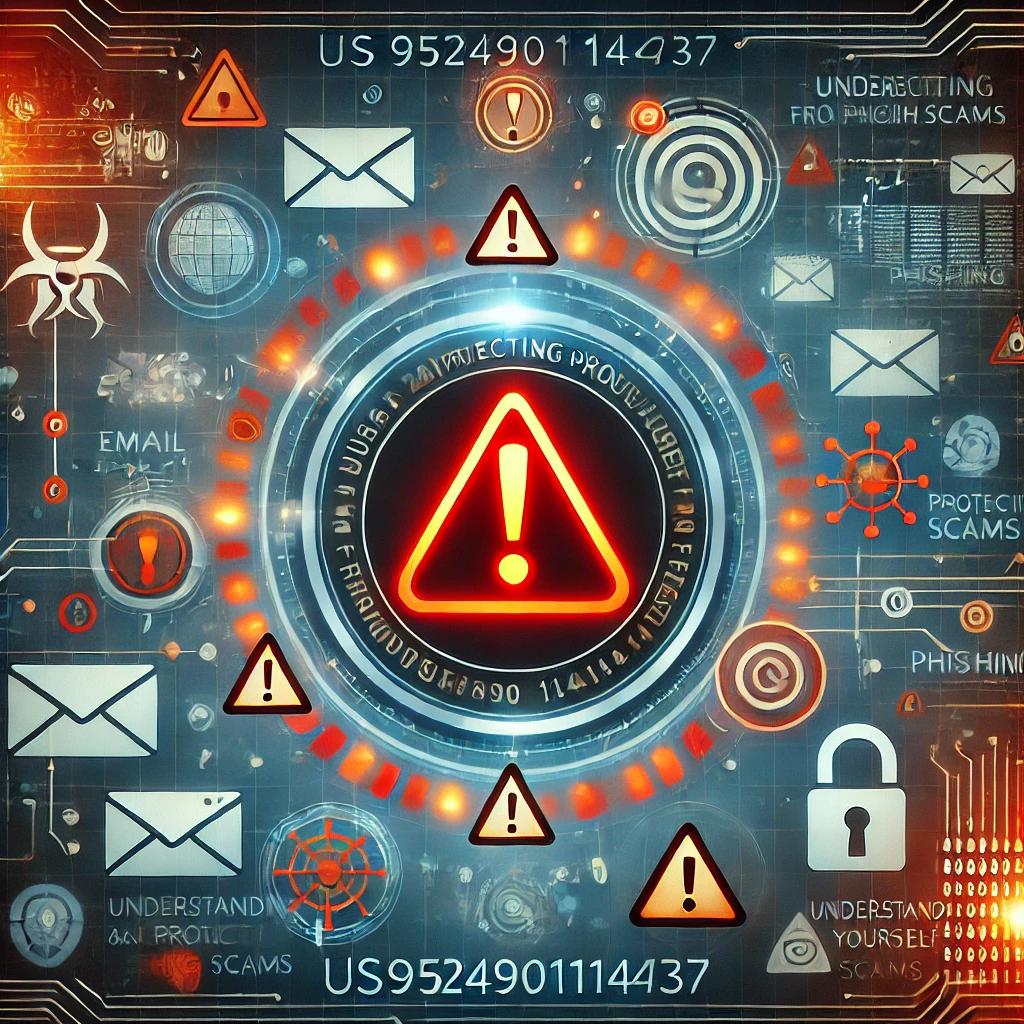Phishing scams have become increasingly sophisticated, and one of the more recent examples is the us9524901144737 scam. This deceptive scheme often tricks individuals into divulging sensitive personal information by mimicking legitimate services like USPS. Understanding how the us9524901144737 scam operates, learning to recognize red flags, and knowing how to protect yourself are crucial steps in safeguarding your information in today’s digital world.
What is the us9524901144737 Scam?
The us9524901144737 scam is a phishing scheme that targets unsuspecting individuals through messages that claim to be from USPS or other trusted organizations. These messages usually alert the recipient to an issue with a package delivery, prompting them to follow a link to verify their address or pay a small fee for redelivery. The message often appears genuine, using tracking numbers like us9524901144737 to create a sense of legitimacy. However, these links redirect users to fraudulent websites designed to steal personal information such as names, addresses, and even credit card numbers.
How the us9524901144737 Scam Works: Step-by-Step
Phishing scams like us9524901144737 follow a series of well-orchestrated steps designed to fool victims into sharing sensitive information. Here’s a breakdown of how the scam typically operates:
- Initial Contact:
The scam usually begins with an email, text message, or voicemail that claims to be from a legitimate source, such as USPS. The message states that there is an issue with a package due to an incorrect address or delivery problem. It often includes a fake tracking number, like us9524901144737, to lend credibility. - Deceptive Redirect:
The message includes a link that supposedly leads to the USPS website or another trusted platform. However, clicking on this link redirects the user to a phishing site—a fraudulent website designed to look like the real thing. These sites often mimic the legitimate service’s branding, from logos to layout, making it difficult to distinguish from the real site. - Solicitation of Personal Information:
Once on the phishing site, the victim is asked to provide personal details to “resolve” the issue, such as their full name, address, phone number, and sometimes even payment information under the guise of paying a redelivery fee. This is where the scammer collects all the sensitive data. - Exploitation:
Once the victim has provided their information, the scammers may sell the data on the dark web or use it to commit identity theft, unauthorized transactions, or open fraudulent accounts. Victims of the us9524901144737 scam often face long-term consequences, including financial loss and compromised personal security.
Recognizing the Red Flags: Key Signs of Phishing Scams
Understanding the key signs of a phishing scam like us9524901144737 is essential for avoiding potential fraud. Here are the common red flags:
- Unsolicited Communications: Receiving unexpected emails, texts, or voicemails regarding package issues or other urgent actions should raise suspicion.
- Urgency and Pressure: Scammers often create a sense of urgency, encouraging victims to act quickly without thinking. If a message urges you to click a link or provide personal details immediately, it’s likely a scam.
- Suspicious URLs: Always check the URL of any website you’re redirected to. Fake URLs often look similar to legitimate ones but contain subtle misspellings or additional words (e.g., USPS-secure365.com instead of USPS.com).
- Request for Sensitive Information: Legitimate organizations rarely ask for sensitive information like credit card numbers or personal details via insecure channels such as email or text messages.
The Broader Impact of Phishing Scams
The us9524901144737 scam is just one of many phishing schemes that cause harm worldwide. These scams can affect individuals, businesses, and organizations by leading to financial loss, data breaches, and identity theft. Scammers take advantage of the growing reliance on digital communication and e-commerce, exploiting trust in postal and delivery services.
Phishing scams undermine trust in legitimate businesses and platforms, making it harder for customers to feel secure when interacting online. The financial toll on victims can range from small unauthorized charges to significant losses due to identity theft or drained bank accounts.
How to Protect Yourself from the us9524901144737 Scam
Protecting yourself from phishing scams like us9524901144737 requires vigilance and proactive steps. Here are key ways to safeguard your personal information:
- Verify the Source: Before clicking on any link in a suspicious email or text message, verify the authenticity of the message by visiting the official website of the organization directly.
- Look for Signs of Authenticity: Legitimate organizations will use secure HTTPS websites. Always check the URL for misspellings or suspicious domains.
- Use Multi-Factor Authentication (MFA): Enable MFA on all important accounts. Even if scammers obtain your credentials, MFA adds an extra layer of protection.
- Install Security Software: Keep antivirus software up to date and use reputable security programs to detect potential phishing attempts.
- Be Skeptical of Unsolicited Requests: Always question unsolicited communications that ask for personal information, especially if they create a sense of urgency.
How to Recover if You’ve Fallen Victim
If you realize you’ve fallen victim to the us9524901144737 scam, there are immediate steps you can take to mitigate damage:
- Change Your Passwords: If you provided login information, change your passwords immediately. Guarantee your new passwords are solid and special.
- Monitor Your Financial Accounts: Keep an eye on your bank and credit card statements for any unauthorized transactions.
- Report the Scam: Contact your bank, credit card company, and the Federal Trade Commission (FTC) to report the scam and request assistance.
- Freeze Your Credit: Consider placing a fraud alert or freezing your credit report to prevent scammers from opening new accounts in your name.
- Notify USPS or Relevant Organizations: If the scam claimed to be from USPS, report the phishing attempt to them and any other relevant organizations.
How Organizations Combat Phishing Scams
Organizations like USPS and other major companies are actively working to combat phishing scams like us9524901144737. Cybersecurity teams are continuously improving detection systems that flag suspicious activity, and companies are employing more secure communication methods.
Some organizations are also educating their customers through regular updates on how to recognize phishing attempts, while encouraging users to report any suspicious emails or texts. Additionally, law enforcement agencies are collaborating globally to track down and prosecute phishing scam operators.
Understanding the Legal and Regulatory Implications
Phishing scams, including us9524901144737, are illegal in most countries and carry significant penalties for those caught running such schemes. Laws regarding cybersecurity, consumer protection, and privacy rights are designed to protect individuals from these malicious attacks.
Governments and regulatory bodies are cracking down on phishing operations, and many are introducing stricter data privacy laws that hold companies accountable for protecting consumer information. However, the legal process of prosecuting these scammers is often complicated due to the international nature of many phishing rings.
Best Practices for Securing Your Personal Information Online
Securing your personal information online is one of the most effective ways to prevent becoming a target of phishing scams like us9524901144737. Here are best practices to follow:
- Use Strong, Unique Passwords: Avoid using the same password across multiple sites and ensure that your passwords are long and complex.
- Enable Two-Factor Authentication: This adds an additional layer of security when logging into sensitive accounts.
- Be Mindful of Sharing Information: Be cautious about the information you share online, particularly on social media, where scammers can gather personal details to target you more effectively.
- Regularly Check Your Accounts: Review your financial and online accounts regularly to spot any unusual activity.
Case Studies of Similar Phishing Scams
Phishing scams like us9524901144737 are not unique. For instance, a similar phishing scam targeted users of popular e-commerce sites, sending fake order confirmations with links that redirected victims to phishing websites. In another case, scammers impersonated popular streaming services, asking users to update their billing information, only to steal their payment details.
Understanding these broader trends in phishing scams helps to illustrate how scammers use different approaches to deceive people.
How to Report Phishing Scams
If you come across a phishing attempt such as us9524901144737, reporting it is crucial to help stop further attempts. You can:
- Report to the FTC: Record a protest with the Government Exchange Commission.
- Notify the Company: If the phishing scam impersonates a legitimate company, report it to that organization.
- Forward Suspicious Emails: Send phishing emails to anti-phishing groups like spam@uce.gov or the company being impersonated.
Conclusion
The us9524901144737 scam is just one example of how phishing scams continue to evolve and target unsuspecting individuals. By recognizing the red flags, taking proactive steps to protect your information, and knowing how to recover if you fall victim, you can significantly reduce your risk of being affected by phishing scams. Awareness and caution are your best defenses against the growing threat of online fraud.


